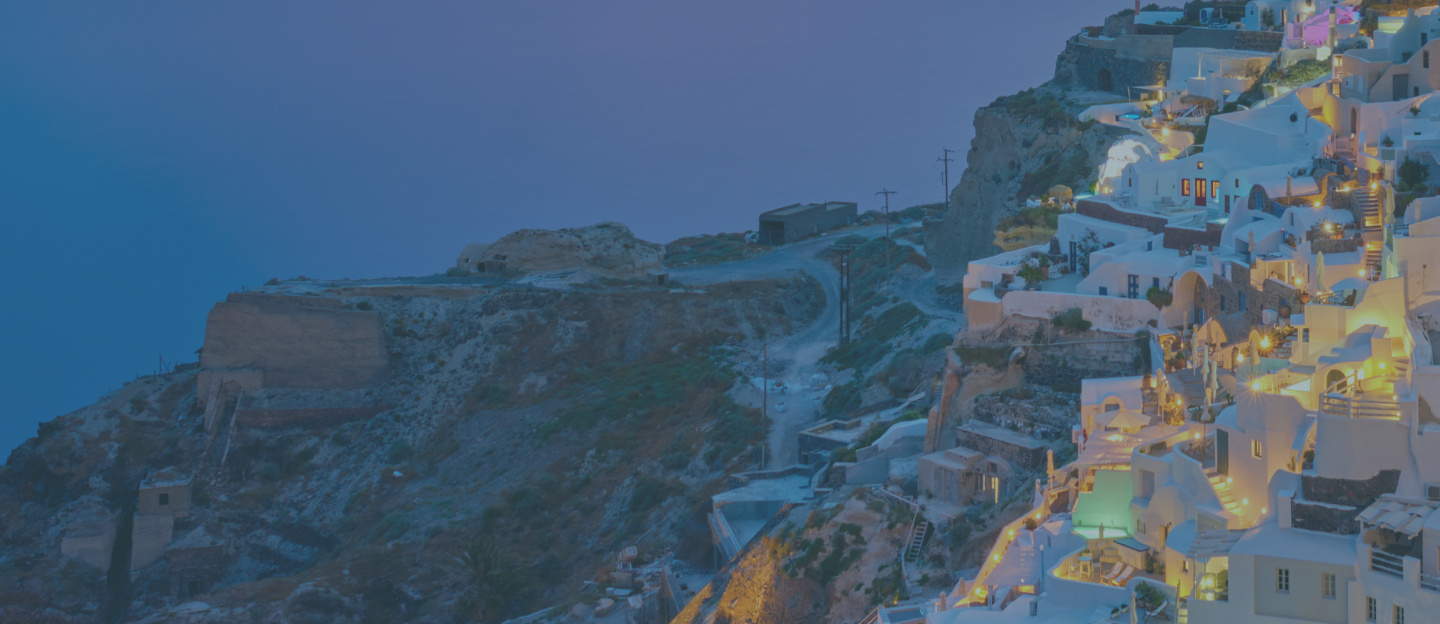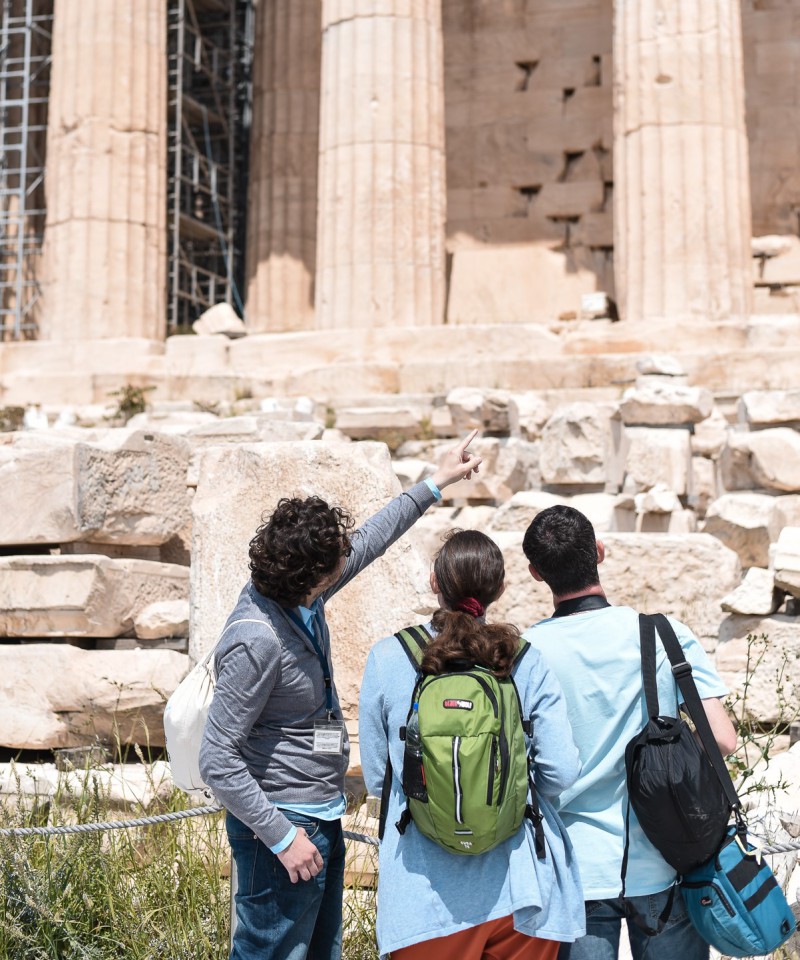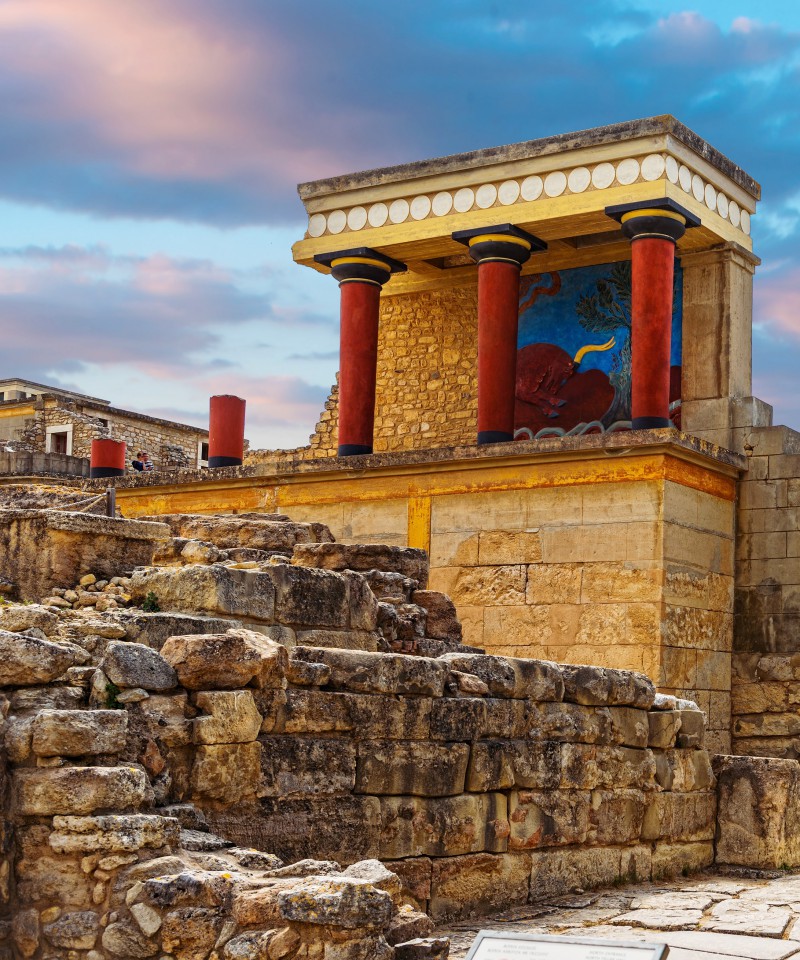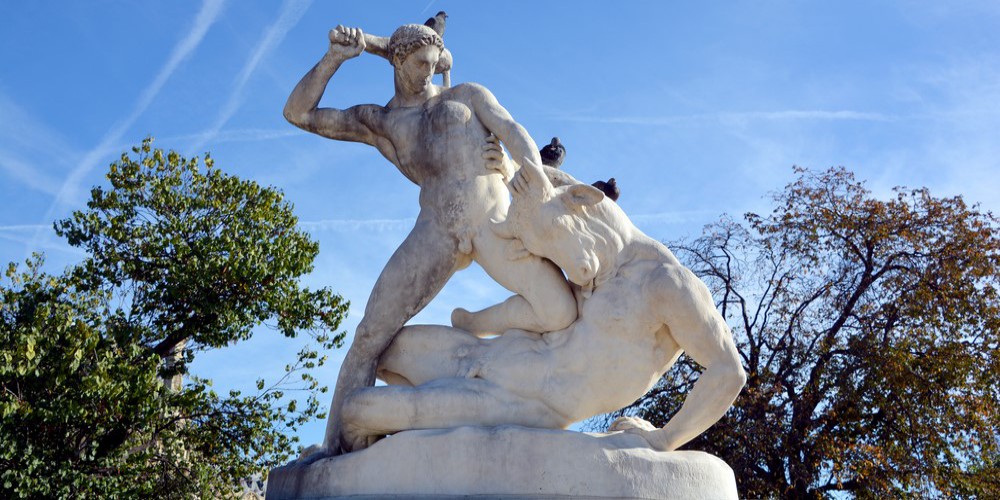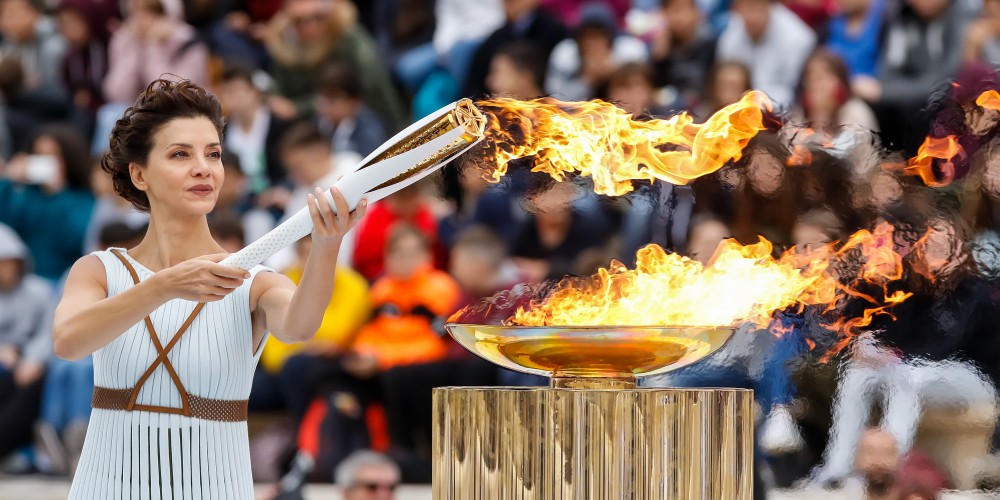
The Most Popular Landmarks In Greece
Key Takeaways
- Greece is a country rich in history and culture, and it is home to several popular landmarks that attract millions of visitors each year.
- The Acropolis of Athens represents the pinnacle of ancient Greek architecture and is a symbol of democracy, philosophy, and artistic excellence.
- Located on the island of Crete, the Palace of Knossos is associated with the Minoan civilization, one of the earliest advanced civilizations in Europe.
- Meteora is a unique UNESCO World Heritage site featuring monasteries perched on towering rock pillars in central Greece. These monasteries were constructed by monks in the 14th and 15th centuries as places of seclusion and spirituality.
Greece has an amazing history full of great conquerors, philosophers, and a naval empire so large that it crisscrossed the globe. This is a look at the famous Greek landmarks that will showcase Greek culture at its best!
Famous Greek Landmarks in Athens
The Acropolis and Parthenon
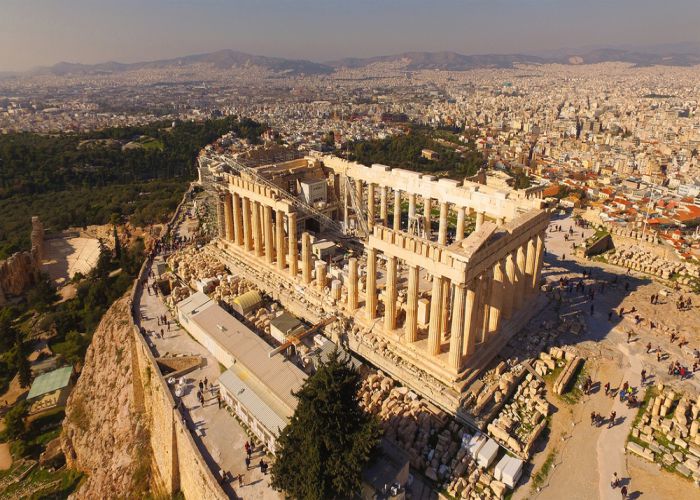
The Acropolis of Athens is the most important archaeological site from ancient Greece, located on a hill in the center of today's Athens, and one of the most famous ancient Greece landmarks that is closely related to Greek Mythology.
In the Acropolis, there are three ancient temples, the Parthenon, the Erechtheion, and the temple of Apteros Nike.
There is also the monumental entrance, the Propylaea, and the ancient theater of Herodes Atticus, known as the Odeon of Herodes Atticus.
All the monuments of the Acropolis are famous landmarks and are made of Pentelic marble and were built during the Golden Age of Pericles.
The Parthenon was dedicated to the goddess Athena, the protector of the city. It was built by the architects Iktinos and Kallikrates under the supervision of the Athenian sculptor Pheidias.
Just opposite the Parthenon is the Erechtheion. It is the temple whose 6 columns have the form of young girls, the Caryatids.
All these monuments on the Acropolis of Athens were preserved for 20 centuries, for 2000 whole years. Unfortunately, they did not manage to escape from Elgin's - the then ambassador to Istanbul- sacrilege.
He removed most of the sculptural decoration of the monuments, entire columns from their bases, and hundreds of objects and transported them all to England and sold them to the British Museum, where they can be found to this day despite Greece’s dismay.
Regardless of whether you're visiting Acropolis with kids, as part of your Greece solo travel, or as a couple, visiting the Acropolis is an opportunity you don't want to miss!
The Ancient Agora of Athens
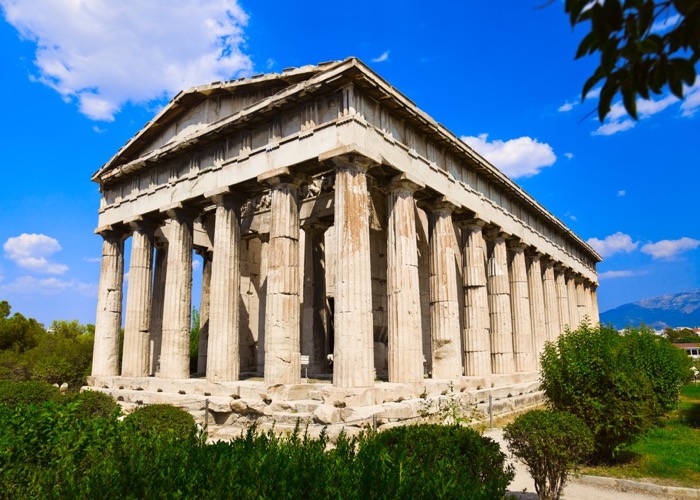
Beneath the hill of the Acropolis lies the Ancient Agora of Athens, another one of the famous landmarks related to Greek Mythology in the capital city.
The place where the Republic of Pericles flourished, where the heart of ancient Athenian society was beating.
The Ancient Agora was a large square at the northwestern foothills of the Acropolis, where social and religious activities, trade, outdoor theatrical events, and sports were held.
But mainly, it was the center of the Athenian Republic as it was the place where the most important administrative and judicial functions were exercised and, of course, political gatherings.
The main buildings of the Agora include the Basilica Stoa, the Bouleuterion, the Dome, the Register, the Altar of the 12 Gods, the Stoa of Attalos, the Various Stoa, the Library of Pantain, the Conservatory of Agrippa, and the temple of Hephaestus.
Panathenaic Stadium
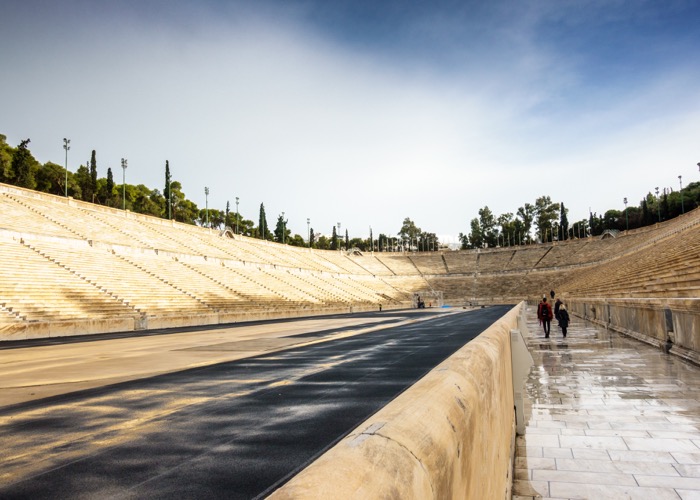
Kallimarmaro, or the Panathinaic Stadium in Athens, was built in ancient Greece in 329 BC. by Lycurgus.
Its foundation took place in order for the Panathenaic festival to be held there in honor of the goddess Athena.
Five hundred years later, in 140 AD, Herod the Atticus, this wealthy Athenian orator and sophist, a member of the Roman Senate and also the first Greek high general, made an extensive renovation of the Stadium, increasing its capacity to 50,000 people.
The Stadium lost its glamor during the Middle Ages. Its renovation began so that the 1896 Olympic Games could be held at the stadium.
At that time, the Panathenaic Stadium was renamed Kallimarmaro, but the ortho-marbling works were completed at the dawn of the 20th century, in 1900.
Today it stands tall in the center of Athens, a few hundred meters only from Syntagma Square. It is a real jewel of the sport's history in the Greek capital and one of its most famous landmarks.
Tower of Winds
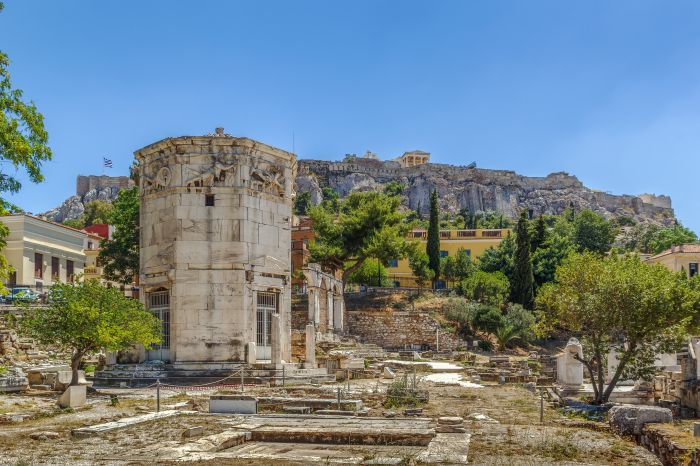
The Tower of the Winds, Ancient Greece landmarks - credits: borisb17/Depositphotos.com
Another of Athens' famous landmarks is the Tower of the Winds. It is an octagonal tower of 13.5 meters made of Pentelic marble in ancient Greece.
There was a Triton-shaped weather vane on the roof, which is not preserved today. Under the cornice of the roof, eight winged relief winds are depicted with their symbols.
Under the winds, the sundials of the monument were probably placed.
Inside there was a hydraulic clock to calculate the time on sunny days but also at night. We do not know exactly how they calculated the time. However, several scientists have come up with different theories.
During the early Christian years, it was transformed into an early Christian church, while a cemetery was created in the surrounding area.
In the 18th century, after the departure of the Venetians and the recapture of the city by the Turks, it was turned into a place of prayer for the Dervishes.
Only in 1843 did it become a place of preservation of antiquities, and a few years later, the restoration of the whole area began.
Mount Lycabettus
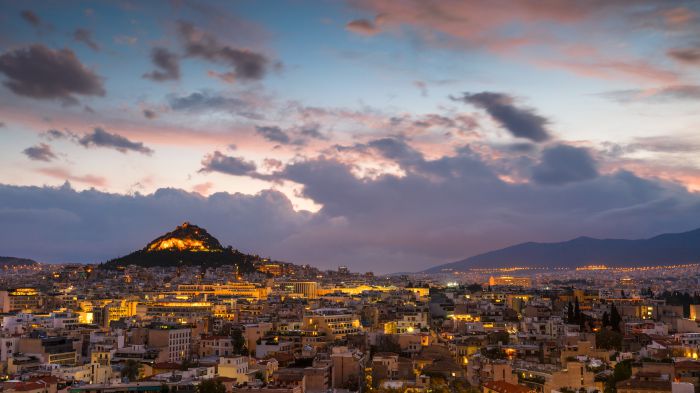
Athens is dominated by a hill, one of the most famous Greece landmarks, which looks like a small mountain.
Lycabettus is a limestone rock and is the second-highest point of the Athens basin after Turkovounia and the highest point in the center of Athens.
It rises to 277 m above sea level and 227 m above the city. Its creation has been attributed to Greek Mythology.
The hill of Lycabettus never bore any particular traces of human activity and never had many buildings. It is, however, one of the most popular landmarks in Athens.
The stone quarries and a large reservoir in the area of Kolonaki, one of the most luxurious Athens neighborhoods, whose external entrance was preserved until the 18th century, are the only ancient works on the hill.
This tank was part of Hadrian's aqueduct, built in the early Roman years at the beginning of the 2nd century AD. by the Roman emperor Hadrian.
Since 1965, a cable car has been installed and operated, transporting visitors to and from the imposing hill. The view from Lycabettus is magnificent and unobstructed in all directions of the city and beyond.
When the weather conditions allow, the Saronic Gulf can be seen, while with the telescope at the top, one can even see the neighboring island of Aegina.
The Tomb of the Unknown Soldier and Changing of the Guards in Athens
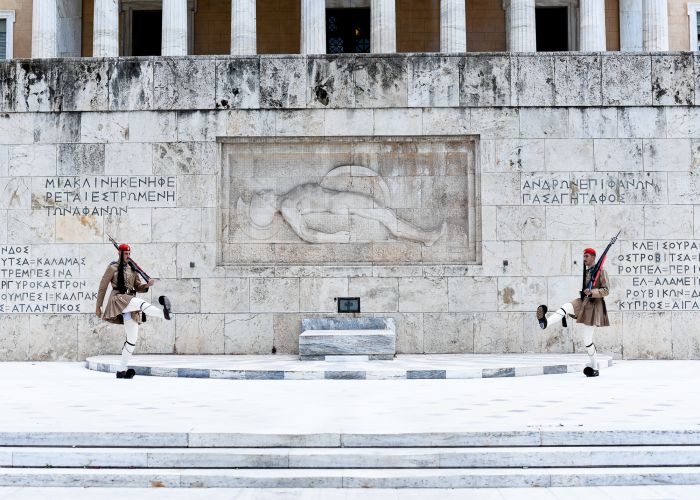
The Tomb of the Unknown Soldier is a burial monument to the invisible victims of the nation's wars -the death of the people who could not be identified.
It is located below the main entrance of the Greek Parliament building and is guarded honorably on a twenty-four-hour basis by the men of the Presidential Guard, also known as the Evzones.
On the wall created behind the tomb, there is a relief depiction of a naked hoplite with a helmet and shield in a supine position.
To the left and right of the representation have been engraved the phrases from the Epitaph of Pericles 'an empty bed is covered with invisible' and 'men of all eminent tombs,' respectively.
The change of guards is one of the most noteworthy sights in the heart of Athens. The soldiers are dressed in the traditional uniforms of Greek freedom fighters. They remain motionless and silent in their magnificent uniform and armor.
Every hour, the shift changes through an amazing ritual that is worth admiring at least once during your stay in Athens.
The New Acropolis Museum
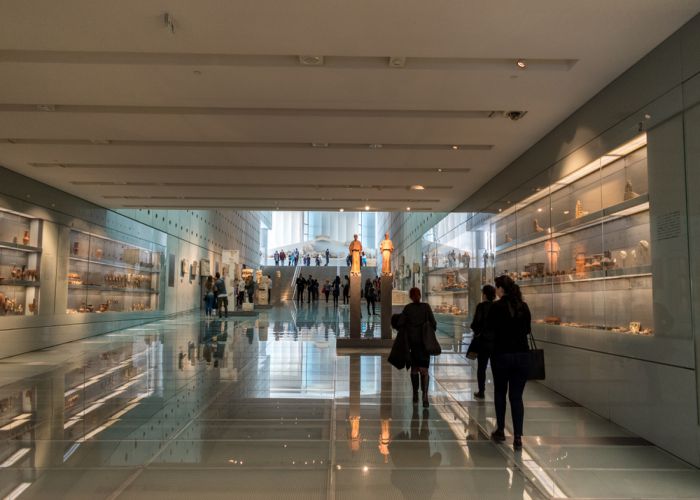
The most famous museum in Athens and the most modern in the country, the Acropolis Museum, opened its gates only in 2009 and, since then, has received more than 10,000 visitors daily.
The building was designed by the French-Swiss architect Bernard Tsoumi. The Acropolis Museum is built around a core with the exact dimensions of the Parthenon frieze sculpted in ancient Greece.
In the 14,000 square meters occupied by the exhibition space of the Acropolis Museum, divided into four levels, the visitor has the opportunity to admire more than 4,000 objects and statues found on the slopes of the Acropolis and its sanctuaries.
The first level of the museum presents findings from the aisles of the Acropolis. The second level presents objects from the Mycenaean period of ancient Greece to the classical.
On the highest level of the museum is the Parthenon Hall, where all the findings of the monument preserved in Athens are exhibited, while in the center of the hall, videos about the history and construction of the Parthenon are presented.
The museum has cafes and restaurants that offer a unique view of the Parthenon and the city, as well as shops selling souvenirs and books related to the Acropolis.
Famous Greek Landmarks on the Greek Islands
Santorini Caldera
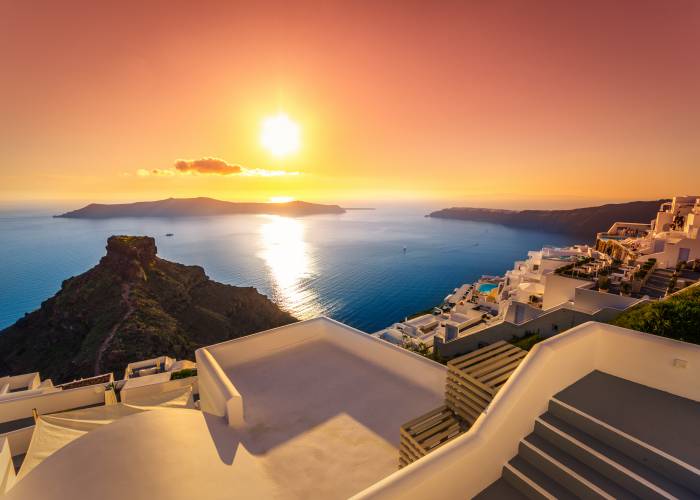
The caldera of Santorini was formed around 1613 BC. Its outline is formed by the islands of Santorini, Aspronisi, and Thirasia.
In the center, there are two small islands, Palea and Nea Kameni, which are made of frozen lava.
By 1940, two craters had formed on Nea Kameni, from where fumes still escape. At the eruption of 1950, magma was shaken from them at a height of one and a half kilometers.
During the last eruption and earthquake of 1956 in the caldera, a tsunami was created, which destroyed all the boats that existed in the area as well as almost all the coastal buildings in the wider area. Then Santorini mourned 53 victims.
Now the sight of Santorini’s caldera and especially the sunset views it offers are some of the most sought-after experiences all around the world and the main reason why Santorini is among the two most popular islands of Greece.
Ancient Delos and the Naxian Lions
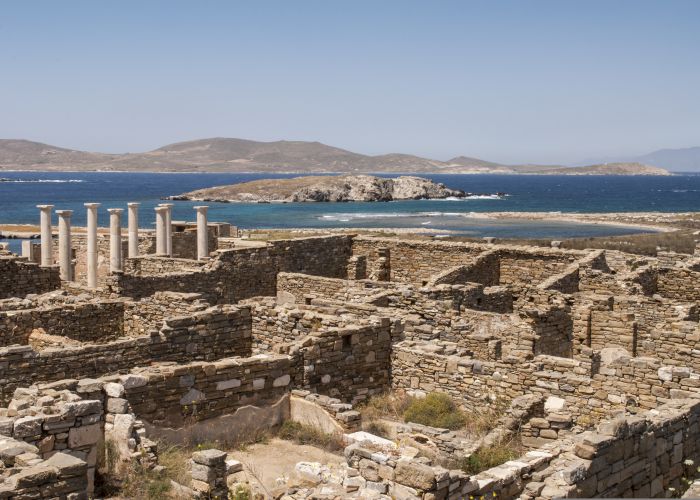
The island of Delos is unique in the whole world as the largest natural island archeological site.
No other island hosts so many monuments of archaic, classical, and Hellenistic times, righteously carrying the title of a UNESCO World Heritage Site.
No one spends the night on the uninhabited island, with visitors arriving daily from the neighboring islands for an unforgettable and magical experience.
Delos had been inhabited since 2500 BC. However, the city, which visitors see today, was developed after 166 BC by the Romans.
The prosperity and commercial development of the island is due to the port that was duty-free, thus constituting a great commercial center.
Most people know the island for the famous Lions Road. The road with its marble Naxian lions was built in the 7th BC. century, when the inhabitants of Naxos wanted to thank god for some of his benevolence.
It must be noted that the lions that one sees today on Lions Street are imitations of the originals since the marble lions are kept in the Archaeological Museum, which was built in 1904 and today has a total of nine rooms.
Mykonos Windmills
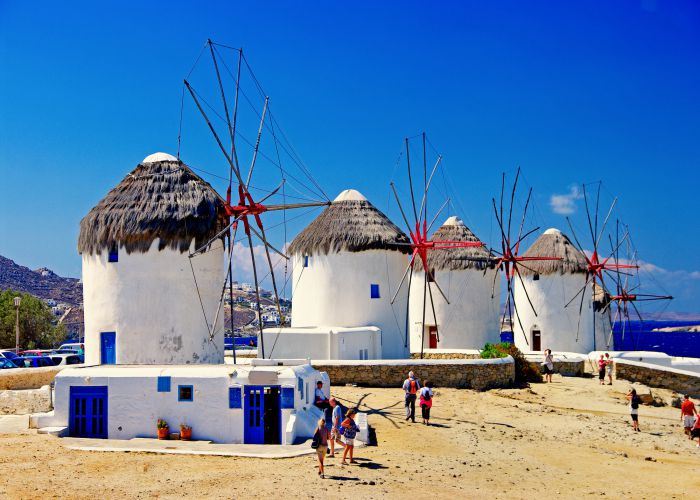
The Windmills of Mykonos Town are one of the most famous Cycladic landmarks. They are located by the sea, southeast of Chora, and boast a stark white color.
They are seven three-story buildings of cylindrical shape, with small windows and a conical wooden roof.
From the 17th to the 19th century, the Mills helped the economy of the island by supplying pastries to the passing ships.
In the 19th century, there were 28 mills, which were the first industrial unit of the island. However, with the development of technology after the First World War, their value began to decline.
The most famous Mill is the 'Boni Mill,' which now operates as an Agricultural Museum where various activities take place.
Also, several of them have been renovated by individuals and are inhabited. The one that is in the best condition is the Mill of Geronymos, which operated until 1960 and still retains most of its equipment.
Spinalonga Island in Crete
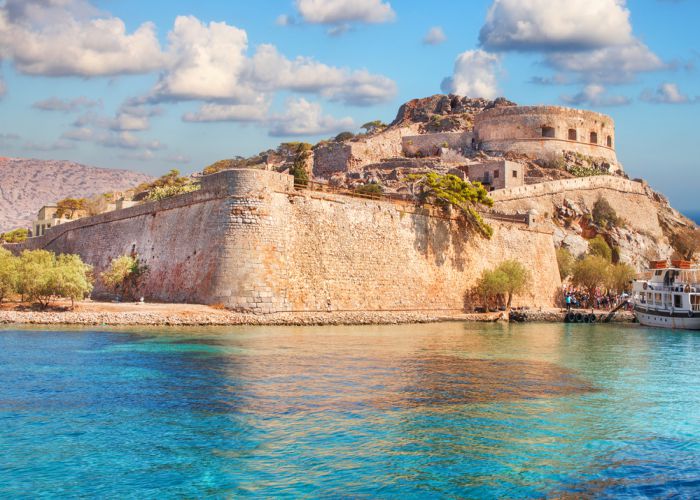
Spinalonga is located in the east of Crete, in the province of Mirabello in the prefecture of Lassithi.
In 1903 it was officially turned into an island of lepers since that’s where society isolated those suffering from Hansen’s disease.
When after 1913, Crete was united with Greece, then even more patients began to come to Spinalonga, ending up hosting even patients from other countries.
Spinalonga was convenient as it had easy communication with the land to transport patients, food, and basic necessities, and there were empty houses after the departure of the Muslims who lived there.
The houses, in fact, were later whitewashed, while the road was opened, a theater, a cinema, and loudspeakers were built, playing classical music in the streets.
There was a cafe, a barbershop, and a church, in order for its inhabitants to continue the most normal life they could.
Nowadays, the island of Spinalonga is visited every summer by 1200-1500 visitors daily by boats from Agios Nikolaos, Elounda, and Plaka, in order to see its ruined buildings up close.
It is, in fact, the most frequently visited archaeological site in Crete after Knossos.
Navagio Beach in Zakynthos
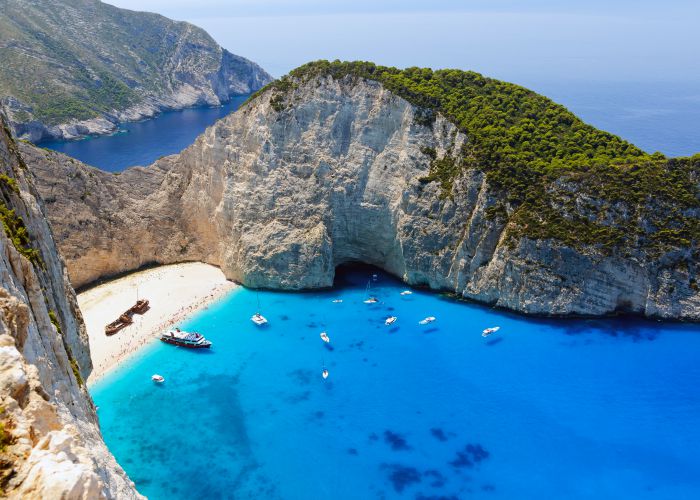
It is a famous beach on the east side of the Greek island near the mountain village of Anafonitria.
Clear waters, white sand, impressive cliffs, and the half-submerged carcass of a ship compose a setting of unique beauty.
The shipwreck is dated to 1983, while the ship that sank was carrying smuggled cigarettes.
With a crew of five and carrying a load of 1895 boxes of cigarettes while it was in the sea area between Kefalonia - Zakynthos, the main engine was damaged and remained unmanned.
As a result, it ran aground on the rocky and steep coast of Zakynthos, where it has been located until today.
Even today, the beach has access only from the sea. From the city of Zakynthos, the neighboring port of Vromi, but also from other parts of the island, daily boats leave for Navagio (or Shipwreck) beach.
The Medieval Town of Rhodes, Rhodes
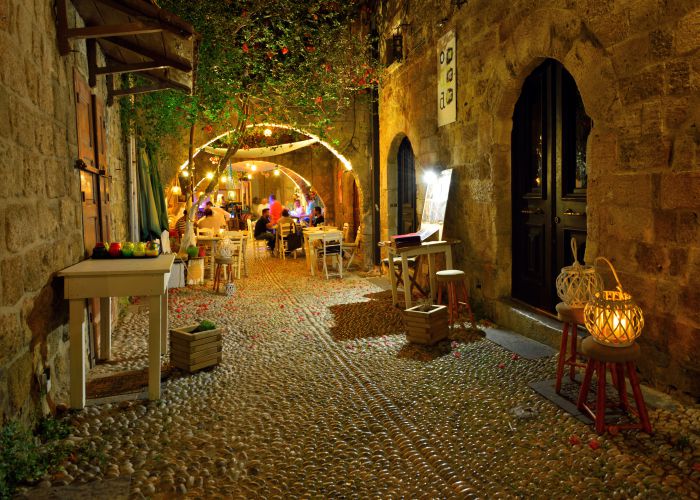
The Medieval Town of Rhodes is a medieval monument of Western European post-Gothic style.
It boasts many elements of the Italian Renaissance appearing in the late 15th century as well as elements of local architecture - one of the few in Europe, now an integral part of the UNESCO World Heritage.
Your wandering in the alleys of the Old Town will bring you to the front of Knights' Street, which is built on a street of the ancient city.
This is the main street of the Old Town, 6 meters wide, where you will find most medieval buildings.
Here are the accommodations of the different ethnicities, with the most impressive being the French, the facade of which is adorned with the Palace of the Grand Master.
Other important sights of the Old Town are the Temple of Aphrodite, the Knights' Hospital, which houses the Archaeological Museum, the Byzantine Museum, the Museum of Decorative Arts, the Suleiman Mosque, and the Palace of Castellania.
The Palace of Knossos in Crete
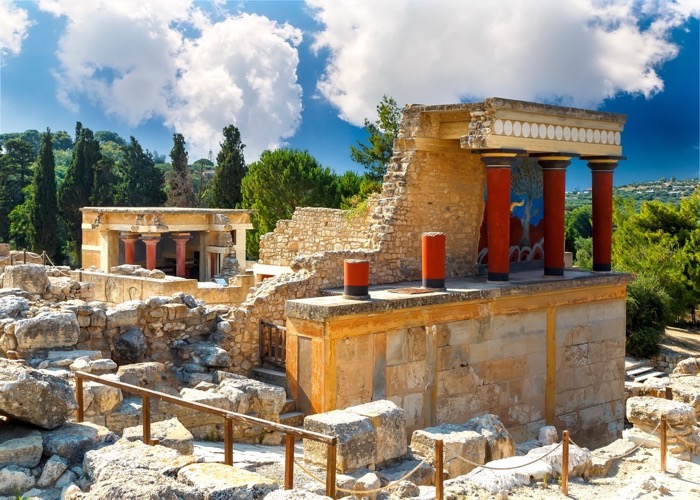
When you visit Knossos Palace, you travel to the depths of European history and works of art that are already 4,000 years old.
The oldest civilization in Europe, home of the legends of King Minos and the Minotaur, is actually the second reconstruction of the largest Minoan palace in Crete after the first was destroyed by an earthquake around 1700 BC.
It is one of the most imposing and famous ancient Greek landmarks.
During its time of glory, the palace was sophisticated and had drainage systems, luxurious five-story houses, and murals that decorated the walls.
It is very large -around an impressive 43,000m2- and once housed 1,300 rooms which were connected by corridors around the main courtyard.
There, you will have the opportunity to meet shrines, storehouses, banquet halls, and the famous Throne Room.
The details of everyday Minoan life are evident everywhere: in irrigation drains, terracotta pipes, drinking water tanks, and, of course, in impressive murals.
The frescoes of the bullfighters as well as that of the dolphins, which decorated the walls of the queen's palace, are symbols of Knossos and the Minoan civilization.
During your time in Knossos Palace, don’t forget to visit the Archaeological Museum of Heraklion and get an even better taste of Minoan grandeur.
Samaria Gorge in Crete
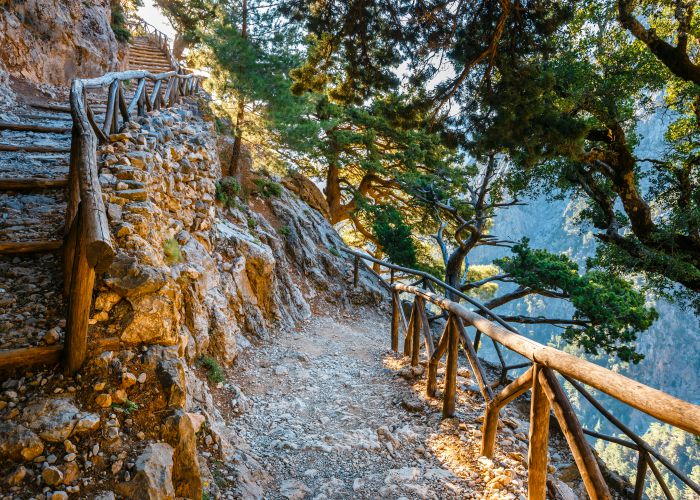
The Samaria Gorge is located in the southern part of the prefecture of Chania in western Crete, south of the Omalos plateau, with most of it belonging to the municipality of Sfakia.
Together with the surrounding slopes and some smaller gorges, it is the Samaria National Park and part of the European path E4.
It has been part of the Biosphere reserve network since 1981, areas that are thus characterized by the UNESCO 'Man and Biosphere' (MAB) program for the promotion and protection of valuable sites for humanity and the environment.
Along with the Olympus National Park, they are the only protected areas in Greece that have joined the network. In addition, the gorge is included in the European Network of Protected Areas NATURA 2000.
It hosts many endemic species of birds and animals, the best known of which is the Cretan chamois, known as ‘kri-kri.’
What’s more, the White Mountains are home to more than 900 species of plants, a number that corresponds to 43% of the species that grow in the phytogeographical area of Crete, which in addition to Crete, includes Kasos, Karpathos, Gavdos, and all the islets that surround Crete.
Famous Greek Landmarks of the Mainland
Temple of Poseidon, Cape Sounion
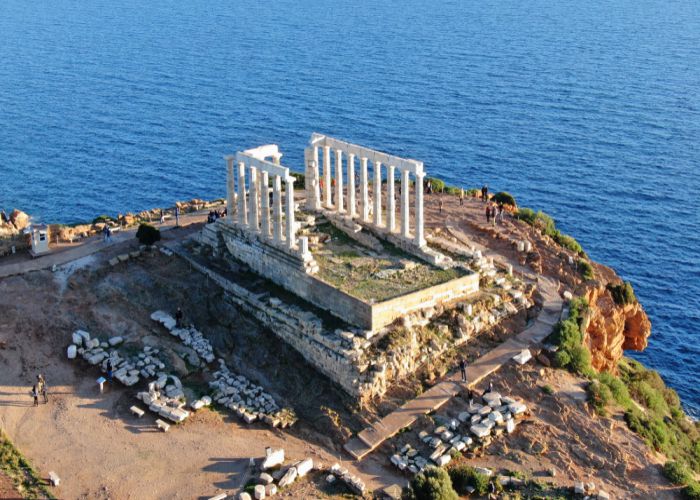
At a distance of about 70 km from Athens, you will find another one of the famous landmarks in Greece, the stunning Cape Sounio.
There, standing proudly on the steep rock, 60 meters high, is the Temple of Poseidon, dedicated to the god of the sea.
It was built between 444 and 440 BC. on the ruins of an archaic temple and was a sacred place, mainly for sailors.
From the rock of Sounio, the visitor has the opportunity to stand in awe before a magnificent sunset, with the Temple in the background and the endless blue of the Aegean sea.
The sea took its name from King Aegean, who stood on the rock waiting to see the return of his son, Theseus, from Crete.
When he saw the black sails, which Theseus had forgotten to change to white, he believed that his son did not succeed against the Minotaur and so threw himself off the rock.
Today, Sounio is an ideal destination for a day trip from Athens that will bring you closer to nature and Greek heritage.
Mount Olympus
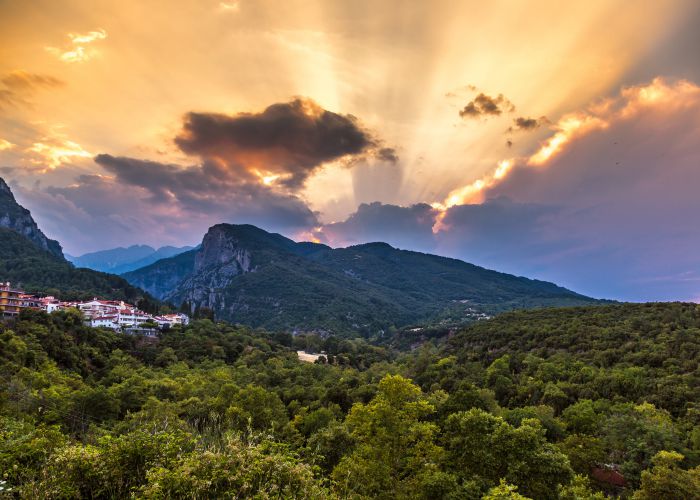
Olympus is the highest mountain in Greece, known worldwide mainly for its mythological context, as its top is believed to be the home of the twelve ‘Olympian’ gods.
It is also the second-highest mountain in the Balkans, but also in the whole region of Europe. For the protection of its unique heritage, in 1938, it was declared the first 'National Park of Greece.'
Every year thousands of nature lovers visit Olympus to admire up close the charm of its nature and enjoy the tour of its slopes. Even more, are the climbers who flock from every corner of the globe to conquer its peaks.
Organized mountain shelters with a variety of mountaineering and climbing routes are available to visitors who want to explore its beauties.
The classic starting point is Litochoro, the seat of the Municipality, at the eastern foot of the mountain, 100 km from Thessaloniki, where at the beginning of each summer ends the world-famous Olympus Mountaineering Marathon.
The Ancient Site of Delphi
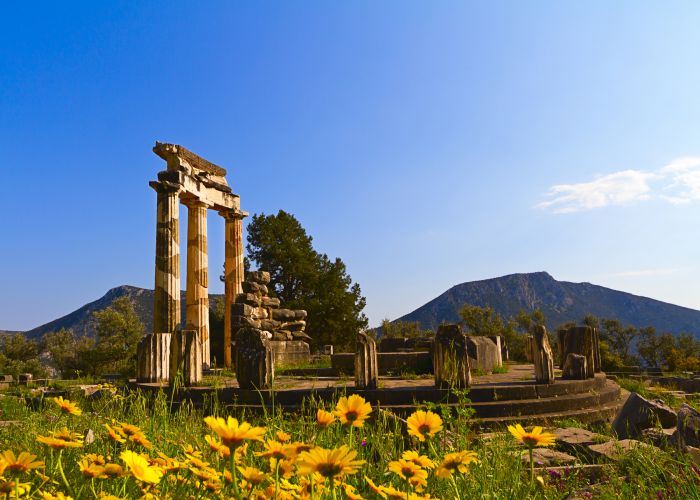
At the foot of Mount Parnassos, in an imposing rocky landscape with mainly bushy vegetation, is the Sanctuary of Delphi, home to the most famous oracle of ancient Greece, alongside an ancient theater.
The history of Delphi, the so-called ‘navel of the Earth,’ the spiritual and religious center of ancient Hellenism, which was one of the most important ancient Greek city states, is lost in the depths of the myths of the ancient Greeks.
The archeological site of Delphi includes two mosques, one dedicated to Apollo and one to Athena, as well as other facilities, mainly of a sports nature.
The oracles of the mythical Pythia, the priestess of the oracle, which were interpreted by the priests of Apollo, were considered the most reliable, resulting in cities, rulers of the time, and ordinary people turning to Delphi for advice.
They were expressing their gratitude to the god Apollo with brilliant votive offerings, which gradually flooded the sanctuary.
With the rise of Christianity, Delphi became the seat of a diocese, abandoned in the early 7th century BC. Nowadays, it is one of the most significant archaeological sites in Greece, beloved by history buffs worldwide. A visit to the ancient ruins will
Monasteries of Meteora
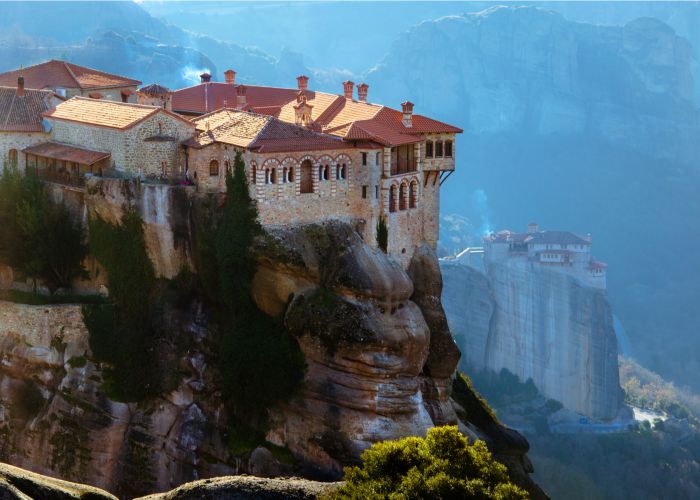
In the Prefecture of Trikala and at a distance of 20 kilometers from the city of Trikala, above Kalampaka, the stone rocks of Meteora rise proudly, full of fossilized shells, testifying to a unique geological phenomenon.
The height of the rocks reaches 400 meters. It is the most important monastery complex in Greece after Mount Athos.
In the 14th century, Saint Athanasios, the Meteoritis, formed the first organized monastic convent and organized it according to the standard of the monasteries of Mount Athos.
From 1350 to 1500 AD, 24 monasteries were founded. However, due to the wear and tear of time, most of them were eventually deserted.
Today, Meteora is recognized as UNESCO World Heritage Site and has earned praise from other international organizations.
There is no doubt it is one of the most famous natural landmarks in Greece and a religious landmark across the world.
The Lions' Gate of Ancient Mycenae in the Peloponnese
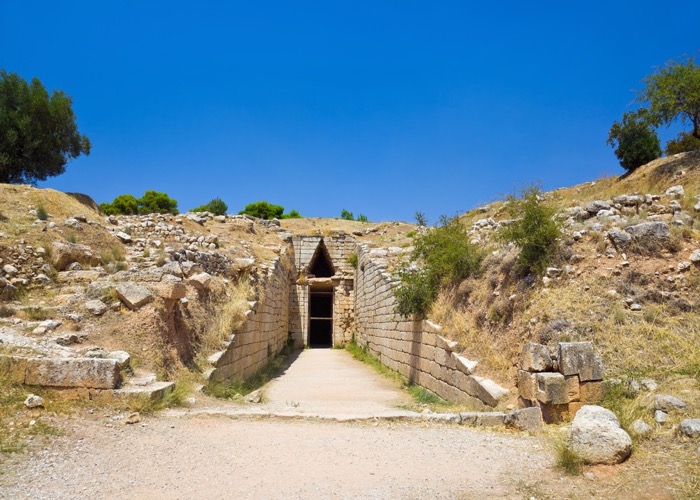
The Lions' Gate is the main entrance to the Mycenaean citadel and was built around 1250 BC. It is the only remaining monument of Mycenaean sculpture, as well as the largest sculpture of the prehistoric Aegean.
Another unique element that this gate has is that it is the only monument from the Bronze Age in Greece that has an iconographic motif and survived without being buried under the ground.
It is a huge and imposing construction: it is 3.10 meters wide and 2.95 meters high. In the opening, there was a double revolving wooden door. The gate itself consists of two large monoliths and a huge lintel.
The prevailing theory is that it is most likely that the lions are a representation of religious content that was relevant to the ancient citadel.
Early finds from Knossos show a goddess surrounded by two lionesses. It is not known whether the lions are male or female, with scientists arguing for both theories.
Regardless, this monument, with its perfect symmetry and naturalistic style, aims to impress the visitor and symbolize the power and prestige of the Mycenaean palace.
The Picturesque Town of Nafplio
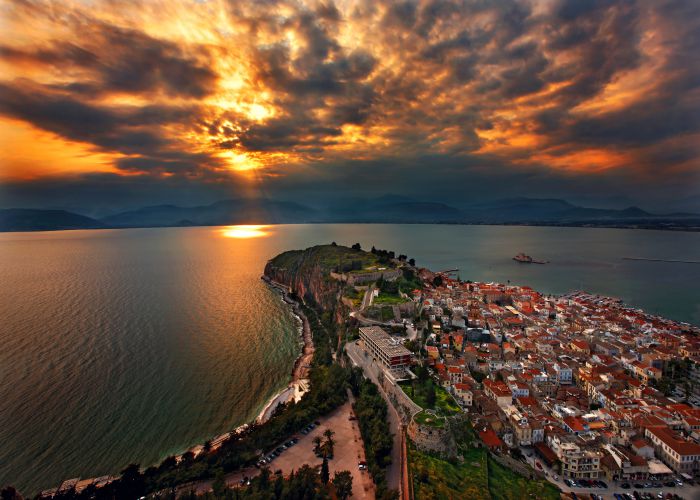
Probably the most charming city of the Peloponnese and one of the favorite destinations for weekends of all seasons.
In the picturesque town of Nafplio, with the preserved architectural feature and the two Venetian castles that crown it, Akronafplia and Palamidi, the aura of the first capital of the Greek state is diffused.
Admire the city from above by climbing the 999 steps that lead to the imposing Palamidi, which stands on a huge gray rock and overlooks the sea.
From Akronafplia, the view of the city is equally impressive, while if you follow the pedestrian street of Arvanitia that surrounds the rock of Akronafplia, you will take an idyllic walk with the sea under your feet.
The heart of the old town stretches behind the shores of Bouboulina and Miaouli, which are full of cafe bars and taverns with a wonderful view of Bourtzi, the small island with the Venetian fortress of the same name.
The main pedestrian street of Vassiliou Konstantinou will become a reference point in every walk, as it crosses almost the whole town and ends at the cobbled Syntagma Square.
There, you can find the Archaeological Museum, the Parliament that housed the first parliament of the free Greek state, and the Old Mosque.
Traditional taverns occupy the entire length of Staikopoulou Street, at the end of which is the Komboloi Museum, which is worth a visit.
The alleys around this road are full of Turkish fountains and Turkish baths, and historic churches, all remnants of Turkish rule.
The two green parks that welcome visitors at the entrance of the city are perfect for getting close to nature through stress-relieving walks.
The Statue of Leonidas at Thermopylae
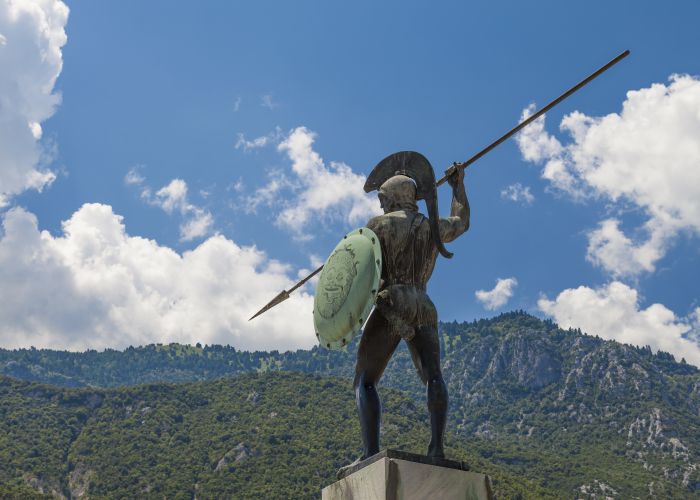
The Statue of Leonidas of Thermopylae, Greece attractions - credits: Anastasios71 /Shutterstock.com
The statue of Leonidas of Thermopylae, built in 1955 by the sculptor Vassos Falireas, is a sculptural composition consisting of the bronze statue of Leonidas with a spear and shield in the center.
On the right and left and at a lower height, we have the marbled figures of the highest mountain in the Peloponnese and Evrotas river. It is now of the most famous landmarks of the region.
The sacrifice of Leonidas and his 300 comrades-in-arms became a timeless symbol in the ancient world, and in the place where Leonidas and his comrades-in-arms fell, the ancients erected a monument with the well-known epigram of Simonides engraved on it:
'Ὦ ξεῖν ’, ἀγγέλλειν Λακεδαιμονίοις ὅτι τῇδε
κείμεθα, τοῖς κείνων ῥημασι πειθόμενοι.'
This translates to: 'Stranger, tell the Lacedaemonians that we are here, faithful to their laws,' meaning: 'we died here following the Spartan traditions.'
After the battle of Thermopylae, a stone lion was erected so that everyone would remember the name of the king who fell at that point. His remains were sent for burial in Sparta in 440 BC.
Today, neither the stone of Leo nor the epigram of Simonides have survived. A copy of the epigram has been placed at the top of Kolonos Hill opposite Iroos, where the last act of the Battle took place.
The statue of Leonidas at Thermopylae has become the top attraction of new Sparta, a monument in front of which people stand in awe and admiration, recalling the history and achievements of ancient heroes who sacrificed their lives for their homeland.
The Castle of Monemvasia
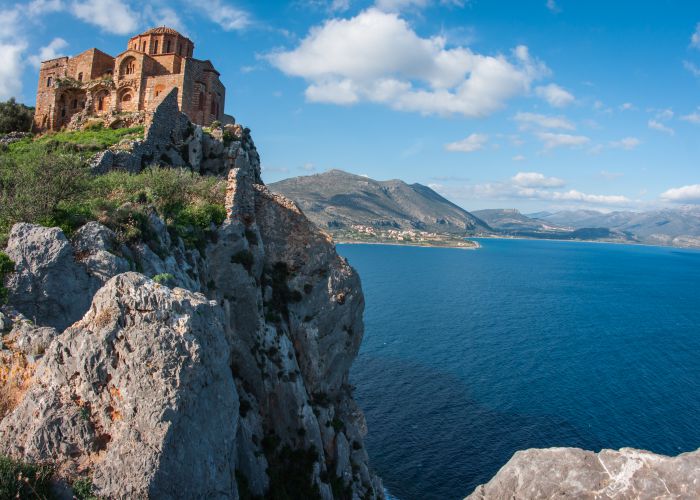
Movemvasia, Greece famous landmarks - credits: _siete_vidas/Shutterstock.com
Within the medieval walls of Monemvasia is one of the most well-preserved and fascinating castle cities in Greece, which attracts visitors from all over the world all year round.
Dozens of churches, mansions of wealthy merchants, fountains, Turkish baths, and cobbled streets are kept in remarkably good condition, preserving the atmosphere of this settlement, which from the Byzantine years to the 19th century, played an important role in the history of the region.
There are no cars allowed inside the castle, so get ready for a walk like in most famous landmarks. The main cobbled path that starts from the gate of the Castle leads you to the most important sights but also to the restaurants, bars, and shops that can be found there.
From the main square with the cannon and the Archaeological Museum begins the cobbled path to the Upper Castle or Goula, the second settlement.
It is worth the uphill between the pomegranates and the date palms if only for the view from the walls of the Upper Castle in front of the imposing church of Agia Sofia.
Monemvasia Castle is a top destination for weekenders and couples. It is great all year round. However, it is the busiest during the summertime and Easter, when nature is in full bloom.
The White Tower in Thessaloniki
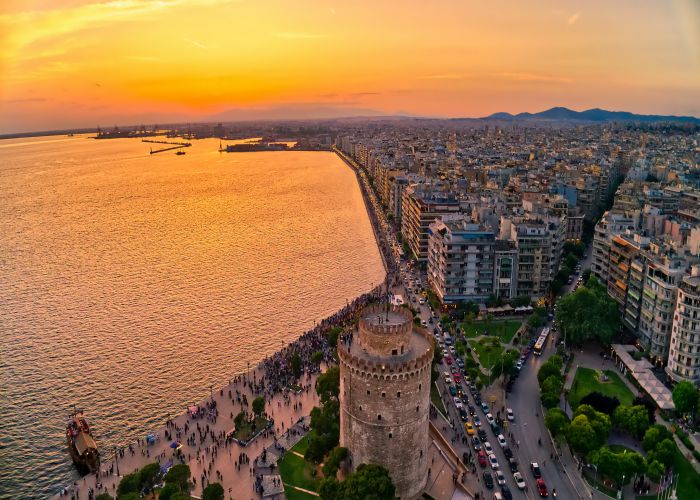
The White Tower used to be called 'The Tower of Blood,' 'The Tower of the Janissaries' by the Christians, and even older, in the 18th century, it was 'The Fortress of Kalamaria.'
Today it functions as a history museum of Thessaloniki, and the use of modern digital media for its narration makes the visit to it worthwhile.
It is a cylindrical building in a prominent position at the beginning of Nea Paralia and is the tallest in the area with a height of 33.90m. and a diameter of 22.70m.
The view from the balcony of the White Tower is panoramic and looks out to the sea of Thermaikos and the mountaintop of Olympus but also to Eastern Thessaloniki.
The Ottomans built the Tower as a fortress to prevent attempts to land by the sea. It had eight floors, 40 internal apartments, three water stores, a dervish sanctuary, and gunpowder depots.
In the summer months, in front of the White Tower, cultural and social events take place almost daily.
A short distance from the White Tower is the two most important museums of Thessaloniki, the Archaeological Museum and the Museum of Byzantine Culture, which are also famous landmarks.
While at a distance of only 400 meters, you will find the statue of Alexander the Great.
The Royal Tombs at Vergina
The small village of Vergina, at a distance of 10 km from Veria and 80 km from Thessaloniki, is one of the most important archaeological sites in Greece.
When visitors approach the area, they notice the existence of several small hills/mounds about five meters high.
Excavations have shown that these hills were part of a large cemetery of the 4th century BC, and each of them contained several tombs.
Vergina was one of the most important cities of the kingdom of ancient Macedonia. The royal tombs of Vergina were discovered during excavations in 1977-1978.
The objects found in the Royal Tombs of Vergina belong to two groups. The first group of objects included 47 broken tombstones found in the huge pile that covered the royal tombs.
The second group of objects belongs to two tombs found inside the Great Tomb. The largest of them is considered to be the tomb of King Philip II of Macedonia. It is the largest and highest Macedonian tomb we know.
The findings in the Great Tomb of Vergina are unique and valuable objects of the ancient Greek world and can be admired at the archeological museum of Vergina.
Mystras
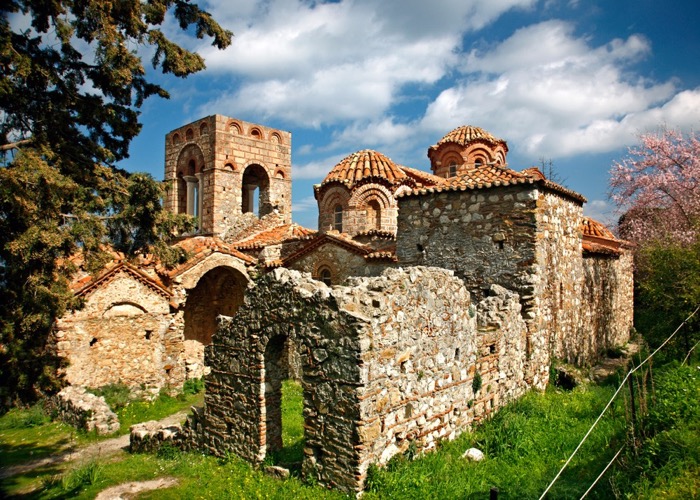
Mystras, famous landmarks, Greece - credits: Heracles Kritikos/Shutterstock.com
Mystras is located in Laconia, five kilometers northwest of Sparta, on a rocky hill at the foot of Taygetos mountain.
The deserted castle city was a brilliant and powerful Byzantine state. It was the swan song of the Byzantine Empire but also the last stronghold of Hellenism before the conquest by the Ottomans, as well as the cradle of Byzantine art and Neoplatonic philosophy.
The castle of Mystras was the core of the later commonwealth of Mystras. The security provided by the hill, due to its natural fortifications, caused the movement of the citizens of Lacedaemonia around the castle.
Over time, Mystras developed into a very important urban center, and the city was formed on three levels.
The archeological site of Mystras consists of the medieval castle and the fortified settlement, which closes through its walls, monasteries, churches, chapels, houses, and palaces.
It is one of the few well-preserved Byzantine settlements that survive to this day.
The restoration works carried out in the last decades by the Archaeological Service gradually add to the glamor of the past. In 1989, Mystras was added to the Unesco List of World Cultural Heritage Sites.
Religious Landmarks in Greece
Church Panagia Ekatontapiliani in Paros
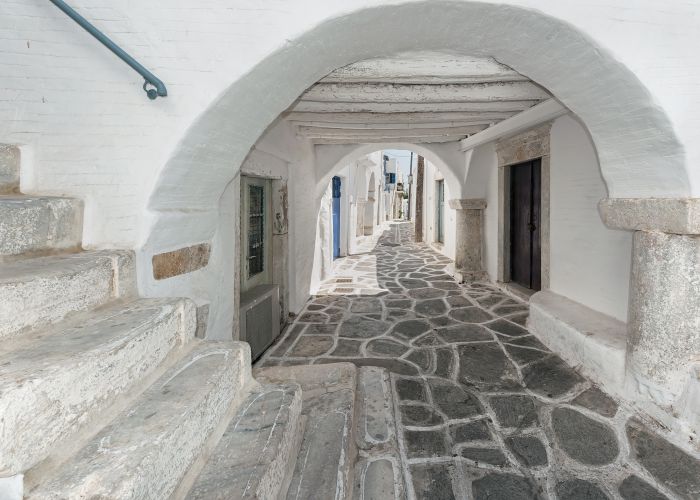
In Parikia, the capital of Paros lies the imposing church of Panagia Ekatontapyliani, which is one of the most famous landmarks of Greece.
It is one of the best-preserved Christian churches in Greece. According to the tradition of Paros, the church was built in the middle of the 4th c. from St. Helen or from Constantine the Great.
The name of the Church - which means ‘100 gates’ - is associated with a legend that dictates the church has ninety-nine open doors and an extra one -the 100th- which is closed and not visible.
It is said that it will be seen and opened when the Greeks take back Istanbul.
The Monastery of Saint John the Theologian in Patmos
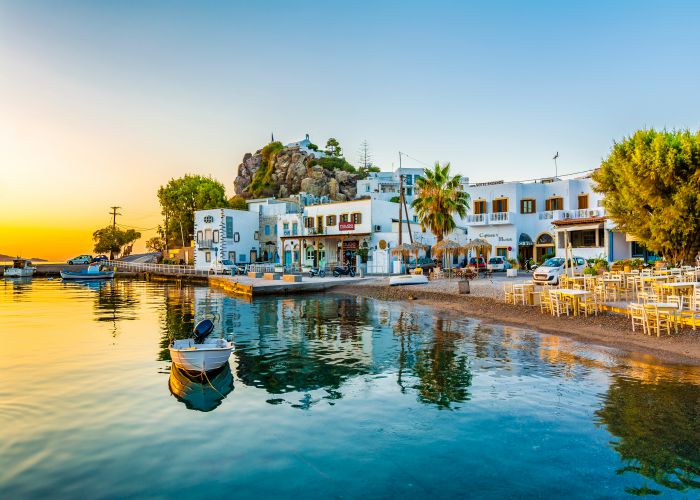
The Holy Monastery of Patmos was founded by Saint Christodoulos. During the Arab period, Patmos was almost deserted.
The founding of the monastery of Agios Ioannis marked the birth of a cultural, spiritual, and religious center, which is a point of reference for the whole Christian world.
Built on the top of a mountain, the Monastery dominates the whole island. Archaeological finds testify that it was built on the site of an ancient temple of Artemis.
Agia Lavra Monastery in Kalavryta
The Historical Monastery of Agia Lavra is located 5 km from Kalavryta and was founded in the 10th century by a hermit.
It was completely burned by the Turks in 1585 and 1827 and by the Germans in 1943. Later, it was rebuilt in its current location and form.
The most valuable treasure found in the monastery is the Banner of the swearing-in of the fighters of 1821, the first flag of the Greek Nation.
Hosios Loukas Holy Monastery in Distomo
The Monastery of Hosios Loukas is founded on a picturesque slope at the western foot of Elikonas, near ancient Sterida.
It is one of the most important monuments of medieval Byzantine art and architecture and is included in the list of UNESCO World Heritage Sites.
Since its foundation, it has played a leading role in the historical adventures of the country, winning the favor of emperors and officials in the Byzantine years.
The Cathedral Of Saint Nektarios in Aegina
The Monastery of Agios Nektarios in Aegina is one of the top attractions of the island as visitors flock to the place by the thousands throughout the year to worship the saint.
He is considered a miracle worker, as Saint Nektarios is believed to have performed miracles while still alive.
The Cathedral Of Saint Nectarios is not only one of the largest Monasteries in Greece but also one of the largest Orthodox churches in the Balkans.
Final Thoughts
And that’s it! The most famous Greek landmarks you need to know about in order to pick and choose while planning your itinerary for your trip to Greece. Of course, for more information and tips about your upcoming trip, make sure to check out the Greece itineraries our expert team has come up with.
With such a plethora of things to admire, you definitely don’t need to worry about spending a dull moment in our country; quite the opposite!
Frequently Asked Questions
What is Greece famously known for?
What are the most interesting landmarks in Greece that all first-time travelers should see?
